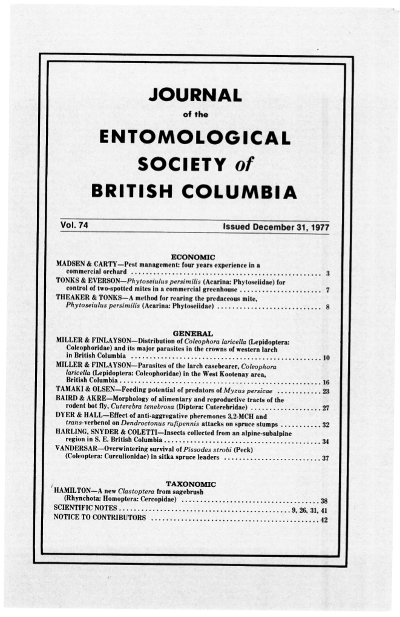Morphology of alimentary and reproductive tracts of the rodent bot fly, <i>Cuterebra tenebrosa</i> (Diptera: Cuterebridae)
Keywords:
rodent bot fly, <i>Cuterebra tenebrosa</i>, Diptera, CuterebridaeAbstract
The internal reproductive and alimentary structures of <i>Cuterebra tenebrosa</i> Coquillett were studied and compared to other calypterate flies. Well defined mouth parts are present. Paired lingual salivary glands extend horizontally almost to the abdomen: however, labial salivary glands were not found. The alimentary canal is complete in female flies, whereas males lack a crop. Females have three spherical spermathecae opening in to the upper portion of the genital chamber. Male reproductive structures are similar to those in other flies. Tracheal air sacs fill one-third to one-half of the abdomen.References
Baird, C.R. and C.L. Graham. 1973. Cuterebra tenebrosa: Description of immature stages and a redescription of the adult (Diptera: Cuterebridae) Can. Ent. 105:1281-1293.
Bennett, G.F. 1955. Studies on Cuterebra emasculator Fitch 1856 (Diptera: Cuterebridae) and a discussion of the status of the genus Cephenmyia Ltr. 1818. Can. J. Zool. 33:75-98.
Catts, E.P. 1963. The biology of Cuterebra latifrons Coquillett (Diptera: Cuterebridae). Ph.D. Dissertation, University of California, Berkeley. 174 pp. (unpub.)
Graham, C.L. and K.J. Capelle. 1970. Redescription of Cuterebra polita (Diptera: Cuterebridae) with notes on its taxonomy and biology. Ann. Entomol. Soc. Amer. 63:1569-1573.
Haas, G.E. and R.J. Dicke. 1958. On Cuterebra horripilum Clark (Diptera: Cuterebridae) parasitizing cottontail rabbits in Wisconsin. J. Parasitol. 44:527-540.
Hewitt, C.G. 1914. The House Fly, Cambridge University Press, London. 195 pp.
Downloads
Published
Issue
Section
License
Authors who publish with the Journal of the Entomological Society of British Columbia agree to the following terms:
-Authors retain copyright and grant the journal right of first publication with the work simultaneously licensed under a Creative Commons Attribution License that allows others to share the work with an acknowledgement of the work's authorship and initial publication in this journal.
-Authors are able to enter into separate, additional contractual arrangements for the non-exclusive distribution of the journal's published version of the work (e.g., post it to an institutional repository or publish it in a book), with an acknowledgement of its initial publication in this journal.
-Authors are permitted and encouraged to post their work online (e.g., in institutional repositories or on their website) prior to and during the submission process, as it can lead to productive exchanges, as well as earlier and greater citation of published work (See The Effect of Open Access).


